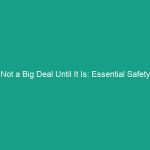Essential Noise Pollution Reduction Guidelines You Must Implement Today
Good morning team! Today, we’re going to discuss a crucial aspect of our Workplace Safety: noise pollution. Noise pollution can significantly impact our health, productivity, and overall well-being. Understanding how to manage noise levels is essential for creating a safe and comfortable work Environment.
Understanding Noise Pollution
Noise pollution refers to excessive or harmful levels of noise that disrupt normal activities, such as sleeping, conversation, or working. In our work environment, noise can come from machinery, equipment, and even conversations among staff. It’s important to recognize that prolonged exposure to loud noises can lead to serious health problems, including hearing loss, stress, and decreased productivity.
Many people underestimate the impact of noise pollution, thinking it only affects those who directly operate noisy machinery. However, even background noise can distract employees and reduce their ability to concentrate. Understanding the importance of managing noise levels is vital for our health and Safety.
Key Hazards, Risks, and Safety Considerations
In any workplace, excessive noise can pose various risks, including:
- Hearing Damage: Prolonged exposure to noise levels above 85 decibels can lead to permanent hearing loss.
- Increased Stress Levels: Constant noise can elevate stress hormones, leading to anxiety and fatigue.
- Reduced Productivity: High noise levels can distract employees, resulting in decreased focus and efficiency.
Ignoring noise pollution can have real-world consequences. For instance, employees may experience difficulty hearing instructions or communicating effectively, leading to potential accidents or injuries. It’s essential to recognize these Hazards to take appropriate action.
Best Practices, Procedures, & Actionable Advice
To reduce noise pollution in our workplace, here are some Best Practices and Procedures you should implement:
- Conduct a Noise Assessment: Identify the sources of noise in your area. This can be done through simple observations or by using a decibel meter to measure noise levels.
- Use Proper Equipment: Ensure that all machinery and tools are well-maintained. Regular Maintenance can minimize noise levels significantly.
- Implement Noise Barriers: Use sound-absorbing materials or barriers to reduce noise transmission. This can include acoustic panels or soundproofing materials in high-noise areas.
- Provide Hearing Protection: If noise levels exceed acceptable limits, provide employees with hearing protection, such as earplugs or earmuffs. Ensure they are trained on how to use them correctly.
- Encourage Quiet Zones: Designate areas in the workplace where noise is kept to a minimum. This can help employees find a space to focus without distractions.
- Regular Training: Conduct regular training sessions on the importance of noise management and how employees can contribute to reducing noise pollution.
For example, a manufacturing facility that installed sound-absorbing panels reported a 30% decrease in noise complaints from employees, significantly improving their overall work environment.
Regulations, Standards, and Compliance
It’s essential to comply with Regulations regarding noise pollution. OSHA (Occupational Safety and Health Administration) sets permissible noise exposure limits to protect workers. Familiarize yourself with:
- osha‘s noise exposure Standards, which specify that employees should not be exposed to noise levels exceeding 90 decibels for an 8-hour workday.
- ISO standards for noise management, which provide guidelines for assessing and controlling noise levels in the workplace.
Compliance with these regulations is not just about avoiding fines; it’s about ensuring a safe working environment for everyone. By following these standards, we can protect our hearing and well-being.
Employee Engagement & Discussion
Now, I want to hear from you. What safety challenges have you encountered related to noise pollution? Have you noticed any areas in our workplace where noise levels are particularly high? Engaging in these discussions helps us identify specific problems and work together on solutions.
Conclusion & Key Takeaways
In conclusion, managing noise pollution is critical for our health and productivity. By implementing the guidelines discussed today, we can create a safer and more comfortable work environment. Remember, our hearing is invaluable, and taking proactive measures can prevent serious health issues down the line.
Thank you for your attention and commitment to safety. Let’s continue to prioritize noise management and work together to ensure a healthier workplace for everyone!


